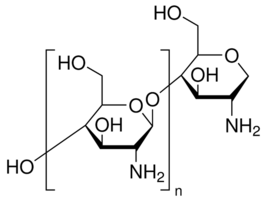
Chemical Analysis
Chitosan is an abundant bio-based polymer with important applications.
Chitosan is produced by deacetylation of chitin, which is the second most abundant natural polymer on earth after cellulose. Chitin is a key structural component in the cell walls of fungi and in the exoskeletons of insects and crustaceans. Chitosan is structurally very similar to cellulose, but different in that each saccharide repeating unit in chitosan contains an amine functional group, which allows for solubility in acidic aqueous media and provides avenues for chemical derivatization.
Chitosan is used in several industries such as agriculture, waste treatment, food/beverage, cosmetics, medical devices, and pharmaceuticals. Chitosan can be further chemically modified by reaction of the amine or hydroxyl groups to produce various chitosan derivatives.
Chitosan is biodegradable, non-toxic, anti-microbial, and renewable which makes it very useful in the biomedical field. Properties such as degree of deacetylation and molecular weight distribution are related to chitosan’s performance and these can be determined using 1H-NMR (ASTM F2103) and SEC-MALS (ASTM F2602).
Approaches
There are several analytical approaches that can be used to characterize chitosan and its derivatives. Two of the most employed methods are nuclear magnetic resonance (NMR) spectroscopy and size exclusion chromatography with multi-angle light scattering detection (SEC-MALS).
Nuclear Magnetic Resonance Spectroscopy (1H-NMR) determines the degree of deacetylation of a chitosan sample. The degree of deacetylation is a measure of the percentage of chitosan repeat units that have been converted from an N-acetylamide form to a free amine form during production of chitosan from its fully N-acetylated starting material chitin. Deacetylation degree is strongly related to performance characteristics of the polymer, such as the ability of the polymer to gel and its solubility (ASTM F2103). NMR analysis is able to directly measure the molar fraction of acetylated repeat units remaining in a chitosan sample with a high degree of accuracy.
Size Exclusion Chromatography with Multi-Angle Light Scattering (SEC-MALS) detection measures the molecular weight distribution of a polymer sample. The molecular weight of a chitosan sample has a direct effect on its solution viscosity. This analytical technique can also be used to determine the polydispersity of a chitosan sample, which is a measure of the breadth of its molecular weight distribution. Commercial chitosans typically have polydispersity values between 1.5 and 3.0 (ASTM F2103).

Sample Considerations
Contact us to learn more about sample considerations for Chitosan Analysis
Applications
Chitosan and its derivatives have a wide variety of applications to include:
- Blood clotting products, such as bandages
- Biopesticides
- Winemaking—preventing Spoilage
- Water filtration
- A filler in pharmaceutical tablets
- A delivery agent for controlled release medications
- Fertilizers
- Drug delivery
- Gene delivery
- Vaccine adjuvants
- Medical devices and implants
